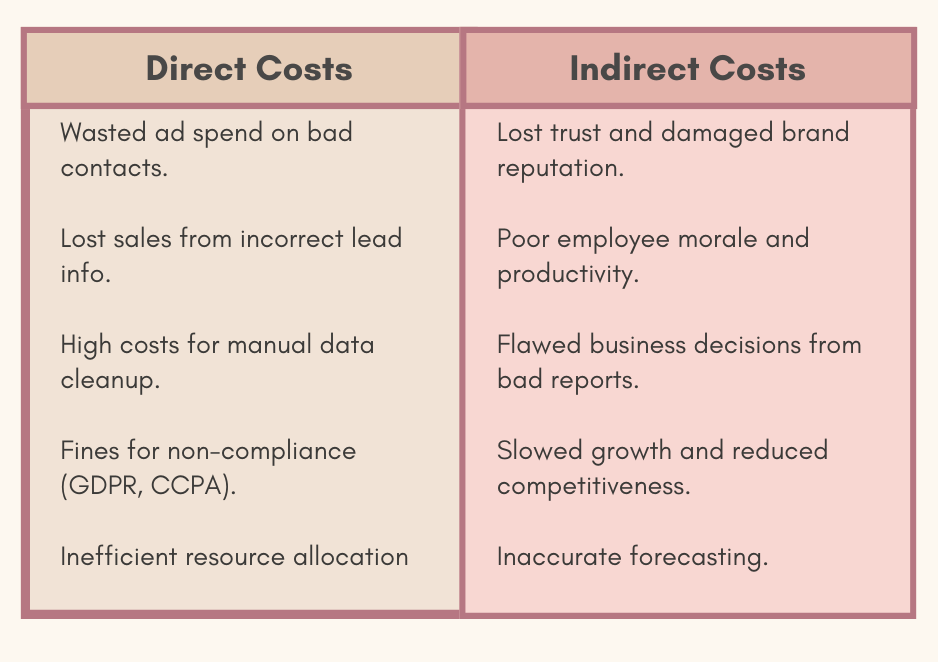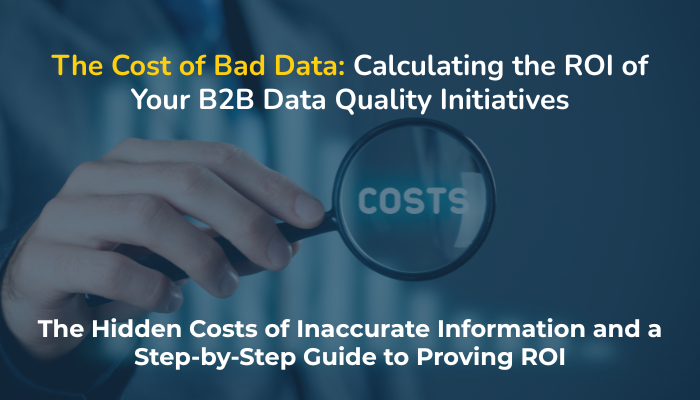Introduction: The Hidden Drain on Your Business
Many businesses treat data as their most valuable asset, yet they’re often unaware of a critical liability hiding within their systems: bad data. This isn’t just a minor annoyance; it’s a significant, and often hidden, financial drain that affects everything from sales to strategy. When a salesperson uses outdated contact information or a marketing team targets an empty lead profile, the cost of bad data adds up quickly.
The solution, however, lies in a fundamental shift in perspective. Instead of viewing data management as a cost, smart businesses are learning to see it as a strategic investment. By calculating the tangible ROI of data quality initiatives, you can prove their value, turning a silent drain on resources into a measurable, profitable asset that fuels growth and improves decision-making.
The Hidden Costs of Poor Data Quality

The 1-10-100 Rule: A Simple Way to Understand the Impact of Poor Data Quality
-
- $1 – Preventing the error at the source
A sales rep enters a new lead into the CRM. A simple email data validation tool flags a typo in real time (“johndoe@gmial.com”), so it’s corrected instantly—costing almost nothing. - $10 – Fixing the error later
Months later, during a database cleanup, your team finds that same incorrect email address. Correcting it requires research or paying for an email data-cleaning service, costing 10x more than fixing it upfront. - $100 (or more) – Doing nothing
The invalid email stays in the system. Marketing sends multiple campaigns to this lead, wasting ad spend, and sales reps chase a dead contact. If this were a key decision-maker, the lost opportunity could cost thousands.
- $1 – Preventing the error at the source
Calculating the ROI of Your Data Quality Initiatives: A Step-by-Step Guide
Step 1: Identify the “Cost of Doing Nothing.”
Before you can measure a return, you need to understand the costs you’re currently facing. This is the most crucial part of the process. Think about all the ways bad data is costing your business. For instance, what’s the average value of a lost B2B lead? How many hours are your sales and marketing teams spending each week on manual data cleanup? These are all part of the cost of poor data quality.
Step 2: Define Your Data Quality Initiatives.
Next, outline exactly what you plan to do to fix the problem. This is your action plan. Will you invest in a data cleansing tool, hire a specialist, or implement stricter data accuracy protocols? Your data initiatives could also include a service for data enrichment to fill in missing information.
Step 3: Calculate the “Cost of the Initiative.”
Now, tally up the expenses associated with your plan. This includes the subscription fees for new software, the salary of any new hires, and the time your existing employees will spend on the project. This gives you the total investment you’re making to improve your data.
Step 4: Estimate the “Savings and Gains.”
This is where you look at the positive outcomes. How much money will your initiative save or help you earn? For example, by fixing data issues <, you might see a higher lead-to-conversion rate, less wasted ad spend, or faster sales cycles. These are the measurable benefits that directly counter the impact of bad data.
Step 5: Put It All Together.
Finally, you can calculate the ROI of your data quality efforts using a simple formula:
ROI=(Savings and Gains−Cost of Initiative)/Cost of Initiative
For example, if you spend $10,000 on a data tool and it helps you gain $30,000 in new revenue by improving data accuracy, your ROI would be 200%. This straightforward calculation helps you build a strong business case and demonstrate that improving your data is a smart, profitable decision.
Building a Culture of Data Accuracy
Beyond the numbers: While the numbers on a spreadsheet are powerful, true and lasting change goes beyond a single project. Data initiatives are not one-off events; they require a fundamental shift in how your entire organization views data.
To achieve this, you must build a culture of data accuracy from the ground up. This starts with securing full leadership buy-in, ensuring that everyone from the top down understands its strategic importance. Next, provide consistent training for all employees on why accurate data is essential for their own success and the company’s growth. It’s also critical to set clear rules for data ownership, so every team knows who is responsible for the quality of the information they use.
Key Strategies:
- Leadership buy-in.
- Training for employees on the importance of data accuracy.
- Setting clear data ownership rules.
- Using automated tools to prevent new data issues.
On a Parting Note –
The Investment That Pays for Itself
Improving B2B data Quality isn’t a cost center or a luxury—it’s a smart, strategic investment that offers a clear and measurable return. By proactively tackling bad data, you’re not just cleaning up a mess; you’re directly reducing wasted spending, increasing sales efficiency, and boosting revenue. The cost of doing nothing far outweighs the expense of implementing data quality initiatives. BizProspex can help you with this. So, stop letting poor data quality costs drain your resources and start seeing data management for what it is: a crucial investment that pays for itself.

